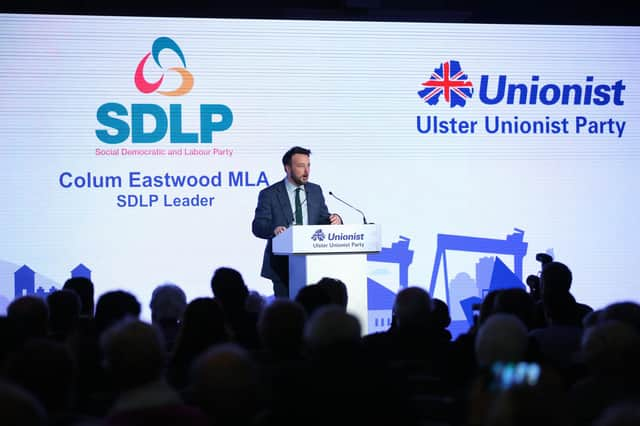Ben Lowry: The Ulster Unionist Party and SDLP are far from finished – unless they want to be so


On broadcasts prominent SDLP and Ulster Unionist politicians talked with a gloom that suggested they were witnessing their own funeral.
No doubt these representatives were trying to show post election humility, which is always preferable in a losing party to a surly defiance of the hard data of the counted ballots. But the SDLP and UUP had a duty to their voters and candidates to find the silver lining in the results and to use it to counter the spin of the more successful parties. The 150,000 people who voted for those two parties could be forgiven for having concluded that they had wasted their vote amid an overwhelming landslide for Sinn Fein and a very strong DUP result.
Advertisement
Hide AdAdvertisement
Hide AdBy last Friday evening, when counting in the council elections was only half finished, various pundits and political rivals – and even members of the SDLP and UUP themselves – were predicting the extinction of those more centrist nationalist and unionist parties. But why? They are nowhere near extinct, unless they actually want to wind themselves down. After what was being billed as a disastrous result for both parties, they still individually polled more than the Alliance Party has done for most of its election history. The SDLP got one of its worst ever votes last week, 8.7%, yet this was almost as much as Alliance got in the Stormont poll of 2017 and more than it did in all prior post Belfast Agreement assembly elections.
The two parties combined still massively outpoll Alliance. Here are the combined UUP and SDLP votes over the last decade, alongside the Alliance vote:
UUP/SDLP total votes Alliance total
2014 council 186,622 / 41,769
2014 European 165,032 / 44,432
2015 Westminster 214,744 / 61,556
2016 Stormont 170,666 / 48,447
2017 Stormont 199,272 / 72,717
2017 Westm’r 178,699 / 64,553
2019 Council 176,739 / 78,052
2019 European 131,641 / 105,928
2019 Westm’r 211,860 / 134,115
2022 Stormont 174,627 / 116,681
2023 local 146,278 / 99,251
And here is another way of challenging the idea that the SDLP and Alliance are on a path to annihilation. It is almost 20 years since both parties were written off, yet their decline has been gradual. It was back in the 2005 Westminster election when the DUP had its big breakthrough, winning 62% of the combined DUP-UUP vote. Last week it won 68 % of that joint vote. Sinn Fein has done better, getting 57% of the joint SF-SDLP vote then, this time 78%.
Another point that the two parties are failing to make in their defence is that declines are not a one-way process. Both the SDLP and UUP had a bad 2017 Westminster election, losing decisively to their bigger rivals, but both surged back in the general election two years later. The DUP got 36% in 2017, more than three times the UUP’s 10%. SF got 29.4%, almost three times the SDLP’s 11.7%. But in 2019 the DUP fell sharply to 30.6% and the UUP rose to 12%, while SF dropped sharply to 22.8% while the SDLP jumped to 15%.
Advertisement
Hide AdAdvertisement
Hide AdThere is no doubt that the SDLP and Ulster Unionists face enormous challenges. One of the biggest difficulties they face is one shared by all small political parties, indeed by bigger parties too: the limited pool of political talent. It is hard for big political parties such as the Conservatives and Labour to find able candidates, and all the more so in a small country such as Northern Ireland. The problem is compounded by the reluctance of many people in a divided society to divulge their political views.
But while finding enough politicians to sustain a party is an immense challenge, huge numbers of people are yearning for the sort of politics that they think the SDLP and UUP might provide. There are at least 150,000 voters, and sometimes 200,000, who want to register that they are unionist or nationalist but simply will not transfer to SF/DUP.
The picture on this page shows Colum Eastwood addressing the UUP conference in 2016, where he got a rapturous reception. That suggested a politics in which the SDLP and UUP looked inward to the centre rather than outwards to their tribe. Such centrist politics never came to pass, but if it had done then the three most centrist parties, combined with Alliance, would even in this supposedly disastrous election for UUP/SDLP have been celebrating 245,529 votes overall, more than SF got in its best ever result.